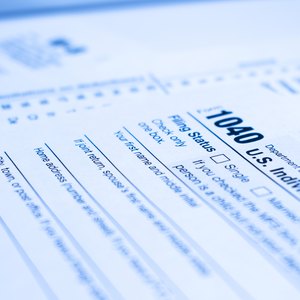
One of the first steps you must take when you start a new job as an employee is filling out the Internal Revenue Service Form W-4. The form helps your employer determine how much federal income tax to withhold from your pay. It helps you avoid tax penalties from underpayment, and completing it correctly also reduces the likelihood that you'll overpay and have to wait for a refund to get your tax dollars back.
The IRS provides detailed instructions and helpful worksheets so you can fill out your W-4 accurately for your personal financial situation, and that's a good thing indeed in 2022. The IRS redesigned Form W-4 in 2020, and it's quite different from the forms you might have filled out before the change.
Why a Revised Form W-4?
You used to have to calculate your "allowances" on the old Form W-4. These allowances were hinged to the personal exemptions you could claim on your tax return through the 2017 tax year, before the Tax Cuts and Jobs Act went into effect and eliminated them from the tax code. You no longer have to figure out your allowances to determine how much should be withheld from your pay. The 2022 Form W-4 reflects that and makes the whole process easier.
The IRS has indicated that the revisions increase the form's "simplicity and accuracy."
What Is IRS Form W-4?
Your employer uses Form W-4 to obtain information about your marital status and your preference for additional federal income tax withholding. They use this document to determine how much federal income tax – but not Social Security or Medicare tax – to collect from each of your paychecks. Social Security and Medicare are flat-rate taxes that apply the same percentage to all taxpayers' incomes.
You might owe the IRS additional money come tax time if too little federal income tax is withheld. On the flip side, too much money taken out for federal income tax can mean you get a refund when you file your taxes. But this is effectively like using the IRS as a savings account for the year...and the IRS doesn't pay interest.
What Does Form W-4 Include?
The boxes and steps on the 2022 Form W-4 are markedly different than they were on the 2019 version, but this one really is much easier to complete. You're basically just answering a series of questions and following step-by-step instructions.
The 2020 form spans several pages, but these pages include instructions and worksheets. You'll find the actual form, the Employee's Withholding Certificate, on the first page. Important instructions for using the form appear on the second page, followed by two worksheets and some income charts to help you along with your calculations.
Complete the first worksheet if you hold down multiple jobs, or if you and your spouse both work. The second worksheet asks for information as to whether you'll be itemizing on your tax return or claiming the standard deduction for your filing status.
How to Fill Out the 2022 Form W-4
Enter your name, address and Social Security number in Step 1, and specify your filing status by checking one of the boxes provided in Step 1(c). You can choose single, married, married filing jointly, married filing separately or head of household.
Complete Step 2 if you hold more than one job, or if you're married and filing jointly and your spouse also works. This is where the worksheet on Page 3 comes in handy. You can use it to calculate your withholding based on your circumstances, or you can use the tax withholding estimator provided on the IRS website. You can leave this section blank if it doesn't apply to you, such as if you're single and you only work one job.
Step 3 asks for information about your dependents. It's used to take into consideration whether you'll be claiming the Child Tax Credit or the Credit for Other Dependents when you file your tax return, because these will affect how much you'll ultimately owe the IRS or receive as a refund.
Completing Step 4 is optional. It gives you some power and control over your tax withholding situation. You can simply ask your employer to withhold more in the way of tax without divulging why – maybe you don't want them to know that you have some sweet investments that kick off unearned income – and you want more tax withheld from your pay to cover this. Or maybe you moonlight as a sole proprietor, but you'd rather your employer not know this, either.
Tips
You can use the second worksheet on Page 3 if you'd like less withheld from your paychecks because of certain deductions you plan to claim on your tax return.
The last step is for you to sign and date the form in Step 5. Your employer will fill out their name and address, your first date of employment, and their employer identification number, so you don't have to deal with these boxes.
You also have the option of simply completing Step 1 and leaving it at that, but this might not be to your advantage. It would force your employer to withhold based only on your filing status and nothing more, not taking in any circumstances that might apply when you file your tax return.
What Is the Exemption From Withholding?
Being exempt from withholding means that no federal income tax will be taken out of your paychecks, although it doesn't affect your Social Security or Medicare tax liability. You'd select this option on your W-4 form only if two conditions apply to your tax situation:
- You had no tax liability last year so all your federal income taxes that were withheld were refunded to you.
- You have no tax liability for the current tax year, either. You expect a full refund of any federal tax your employer withholds.
You can claim an exemption on the 2022 form by simply writing "EXEMPT" in the space provided below Step 4(c). You must still complete Steps 1(a) and 1(b) with your identifying information, and sign and date Step 5.
Declaring an exemption from withholding only covers the period through Feb. 15 of the next tax year, or the following business day if this date falls on a weekend or a federal holiday. So your exemption would expire on Feb. 15, 2023 if you filled out a W-4 for the 2022 tax year. You'd have to submit a new W-4 by this date if you expect to be exempt again in 2023.
How to Submit a New W-4
The IRS allows you to submit a new W-4 form and change your withholding at any time. It's a good idea to fill out a new W-4 form to give to your employer whenever your tax or job situation changes. This will ensure that your employer doesn't take too little or too much federal income tax out of your paychecks. These changes can include getting married or divorced, taking on or quitting a second job, gaining or losing a dependent, or becoming eligible for credits like the Child Tax Credit.
You should also adjust your withholding to have just the right amount of tax taken out if you end up with a big tax bill or a refund when you file your return.
You don't have to complete the 2022 version of Form W-4 if you already have an older version on file with your employer because you've worked there for a while. Your employer will continue to base your withholding on your old form until you submit a new one with changes.
Where Can You Find Form W-4?
Your employer should give you a W-4 form to fill out as part of your onboarding process when you're hired. You can likely obtain a new one from your employer or from your workplace's human resources department if you want to make changes to your form. You can also find Form W-4 through the "Forms and Instructions" link on the IRS.gov homepage. You can fill out most of the info in your computer's PDF reader, but you'll still have to print the form and physically sign and date it.
Contact the IRS by phone at 1-800-829-3676 to request the form if you'd prefer to have a copy mailed to you.
Read More: W-2 Forms: What It Is, Who Gets One and How It Works
References
- IRS: IRS Withholding Calculator
- IRS: Topic Number 753 Form W-4 – Employee's Withholding Allowance Certificate
- IRS: Forms, Instructions & Publications
- IRS: Publicastion 15, (Circular E), Employer's Tax Guide for Use in 2019
- IRS: FAQs on the 2020 Form W-4
- IRS: Form W-4 Employee's Withholding Certificate 2022
Writer Bio
Ashley Donohoe has written about business and technology topics since 2010. Having a Master of Business Administration degree, bookkeeping certification and experience running a small business and doing tax returns, she is knowledgeable about the tax issues individuals and businesses face. Other places featuring her business writing include Zacks, JobHero, LoveToKnow, Bizfluent, Chron and Study.com.

